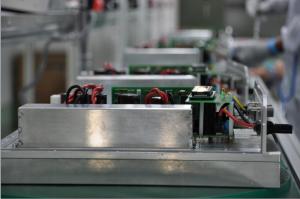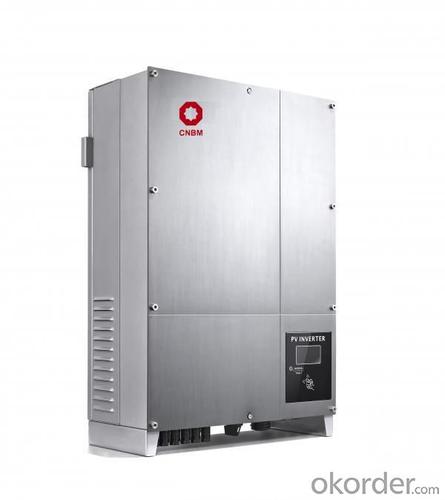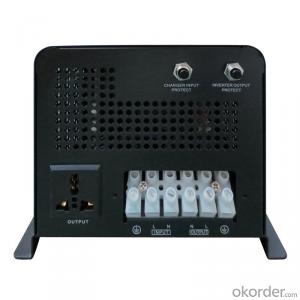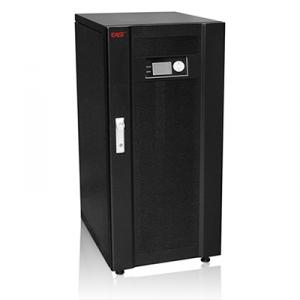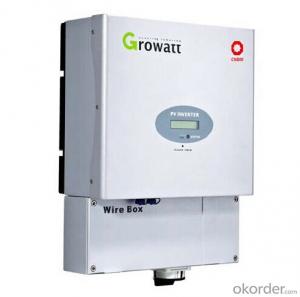Solar Inverter and Charge Controller - Grid Tied 3-Phase CNBM-12000UE
- Loading Port:
- NanJing
- Payment Terms:
- TT
- Min Order Qty:
- 1 set set
- Supply Capability:
- 1000 per month set/month
OKorder Service Pledge
OKorder Financial Service
You Might Also Like
Features of Grid Tied Solar Inverter 3-Phase CNBM-12000UE
With a R&D team more than 100 engineers,40% of the staff, who has been deeply engaged in the photovoltaic industry for 10 years, CNBM takes the mission to increase the inverter availability and efficiency, putting continuous innovation to make CNBM inverter easier for installation and operation, and more cost-effective for solar plant construction. The full range of CNBM single phase inverters has received VDE, CE, G83/1, G59/2, ENEL2010, VDE4105, C10/C11, AS4777 etc.
The Grid Connected Solar Inverter we can offer is 1.5kw to 20kw.
Introduction of Grid Tied Solar Inverter 3-Phase CNBM-12000UE
Maximum efficiency of 97.8% and wide input voltage range
Integrated DC switch-disconnected
MTL-String
Sound control
Bluetooth/RF technology /Wi-Fi
Transformerless GT topology
5 years warranty (10 years as optional)
Technical data of Grid Tied Solar Inverter 3-Phase CNBM-12000UE
Model | CNBM-10000UE | CNBM-12000UE | |
Input data (DC) |
|
| |
Max. DC power | 10500W | 12500W | |
Max. DC voltage | 1000V | 1000V | |
Start voltage | 350V | 350V | |
PV voltage range | 180V-1000V | 180V-1000V | |
Max. input current | 15A | 17A | |
Number of MPP trackers /strings per MPP tracker | 2/2 | 2/2 | |
Output (AC) |
| ||
Rated AC output power | 10000W | 12000W | |
Max. AC power | 10000VA | 12000VA | |
Max. output current | 16A | 19A | |
Power factor | 1 | 1 | |
THDI | <3% | <3% | |
AC connection | Three phase | Three phase | |
Efficiency |
| ||
Max. efficiency | 98% | 98% | |
Euro weighted efficiency | 97.5% | 97.5% | |
MPPT efficiency | 99.5% | 99.5% | |
Protection devices |
| ||
Output over voltage protection-varistor | yes | yes | |
Ground fault monitoring | yes | yes | |
Grid monitoring | yes | yes | |
General Data |
| ||
Dimensions (W / H / D) in mm | 740/440/235 | 740/440/235 | |
Weight | 41KG | 41KG | |
Operating temperature range | –25°C ... +60°C | –25°C ... +60°C | |
Altitude | 2000m(6560ft) without derating | ||
Self-Consumption night | < 0.5 W | < 0.5 W | |
Topology | Transformerless | ||
Cooling concept | Natural | Natural | |
Environmental Protection Rating | IP65 | IP65 | |
Features |
| ||
DC connection | H4/MC4(opt) | H4/MC4(opt) | |
Display | LCD | LCD | |
Interfaces: RS485/RS232/Bluetooth / RF/Zigbee/Wifi | yes/yes/opt/opt/opt | ||
Warranty: 5 years / 10 years | yes /opt | ||
Certificates and approvals | CE、VDE 0126-1-1、DK5940、G83/1-1、G59/2、RD1663、EN50438、 VDE-AR-N4105、CEI-021、IEC-62109、ENEL-Guide | ||
Grid Tied Solar Inverter 3-Phase CNBM-12000UE is simple national setting of line supply monitoring, Easy country configuration, with Multi-language,display, currently available for most of the countries over the world.With technical creativity and scientific management, the factory established first class R&D and test centers, as well as management and R&D teams comprising of PhDs and masters with overseas qualification.
Figure 1 the application of Grid Tied Solar Inverter 3-Phase CNBM-12000UE
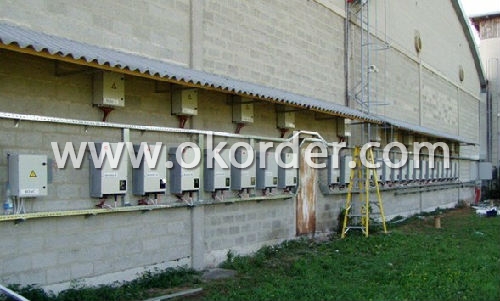
Figure 2 The Stock of Grid Tied Solar Inverter 3-Phase CNBM-12000UE
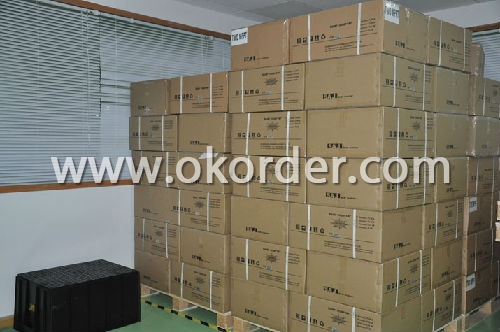
- Q: How does a solar inverter handle overloading?
- A solar inverter handles overloading by constantly monitoring the power output from the solar panels. If the demand for electricity exceeds the maximum capacity of the inverter, it automatically reduces the power output to a safe level. This prevents the inverter from getting damaged and ensures a stable and reliable power supply.
- Q: What certifications should a solar inverter have?
- A solar inverter should have certifications such as UL 1741, IEC 62109, and IEEE 1547 to ensure its compliance with safety standards, grid interconnection requirements, and performance reliability.
- Q: What is the role of a power management system in a solar inverter?
- The role of a power management system in a solar inverter is to efficiently manage the flow of electricity from the solar panels to the grid or the connected devices. It ensures that the power generated by the solar panels is optimized, regulated, and synchronized with the grid's requirements. The power management system helps in maintaining the stability and reliability of the solar inverter system by monitoring, controlling, and adjusting the power flow, voltage levels, and frequency to prevent overloading or underutilization of the solar energy.
- Q: Can a solar inverter be used with multiple solar arrays?
- Yes, a solar inverter can be used with multiple solar arrays. In fact, many solar installations utilize multiple solar arrays to increase the overall power output. The solar inverter converts the DC power generated by the solar arrays into AC power that can be used in homes or fed back into the grid. It is designed to handle the combined power output from multiple solar arrays, allowing for efficient utilization of solar energy.
- Q: Do I need a special inverter for a battery storage system?
- Yes, a special inverter is needed for a battery storage system. Unlike a regular inverter that converts DC power from solar panels into AC power for immediate use, a battery storage system requires an inverter that can not only convert DC power to AC power but also manage the charging and discharging of the batteries efficiently. This special inverter is designed to work seamlessly with the battery storage system, ensuring optimal performance and maximizing the utilization of stored energy.
- Q: How does a solar inverter handle variations in solar panel cleanliness?
- A solar inverter is not directly responsible for handling variations in solar panel cleanliness. However, a clean solar panel allows for maximum absorption of sunlight, resulting in optimal energy production. If solar panels are dirty, the amount of sunlight absorbed decreases, leading to reduced energy generation. It is the responsibility of the solar panel owner to regularly clean and maintain the panels to ensure their efficiency.
- Q: What is the standby power consumption of a solar inverter?
- The standby power consumption of a solar inverter refers to the amount of power that the inverter consumes when it is in standby mode or not actively converting solar energy into usable electricity. This power consumption is generally very low, typically ranging from 1 to 5 watts, as the inverter only needs to maintain its internal circuitry and monitor the solar energy availability.
- Q: What are the advantages of using a solar inverter with battery storage?
- There are several advantages of using a solar inverter with battery storage. Firstly, it enables the storage of excess solar energy generated during the day, which can be utilized during the night or during periods of low solar generation. This allows for greater self-consumption of solar energy and reduces reliance on the grid, resulting in potential cost savings on electricity bills. Additionally, solar inverters with battery storage provide backup power during power outages. The stored energy in the batteries can be used to power essential appliances and devices, ensuring uninterrupted electricity supply. Furthermore, using a solar inverter with battery storage promotes energy independence and sustainability. By storing and using solar energy, individuals can reduce their carbon footprint and contribute to a cleaner environment. It also provides flexibility in energy management, as users can choose when to draw energy from the grid or from the batteries, depending on the energy rates or their specific needs. Overall, integrating battery storage with a solar inverter offers increased energy efficiency, cost savings, backup power, and environmental benefits, making it a compelling solution for residential and commercial solar installations.
- Q: Can a solar inverter be used with a solar-powered data center?
- Yes, a solar inverter can be used with a solar-powered data center. A solar inverter is an essential component that converts the direct current (DC) generated by solar panels into usable alternating current (AC) electricity for powering electrical devices and systems, including data centers. By using a solar inverter, a solar-powered data center can efficiently utilize the renewable energy generated by solar panels to meet its power requirements.
- Q: What is the role of a power factor controller in a solar inverter?
- The role of a power factor controller in a solar inverter is to regulate and optimize the power factor of the inverter's output. It ensures that the power drawn from the grid or generated by the solar panels is in sync with the voltage and current, minimizing reactive power and maximizing the efficiency of the system. By maintaining a high power factor, the power factor controller helps reduce energy losses, improve overall system performance, and comply with grid regulations.
Send your message to us
Solar Inverter and Charge Controller - Grid Tied 3-Phase CNBM-12000UE
- Loading Port:
- NanJing
- Payment Terms:
- TT
- Min Order Qty:
- 1 set set
- Supply Capability:
- 1000 per month set/month
OKorder Service Pledge
OKorder Financial Service
Similar products
Hot products
Hot Searches
Related keywords

